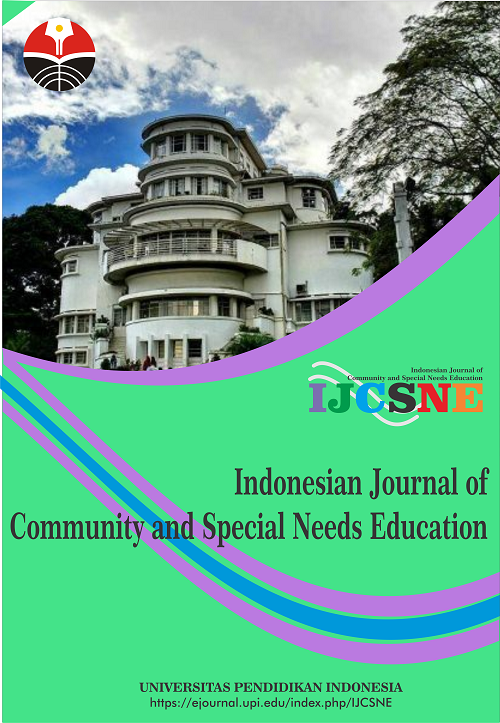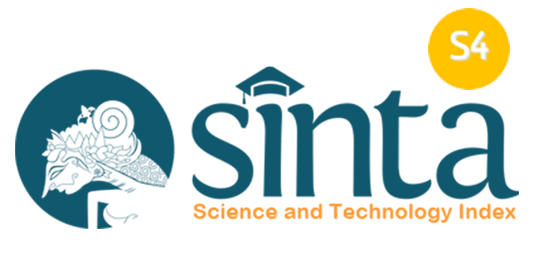Organization of Extracurricular Physical Education at School and Its Role in the Physical and Mental Improvement of Students
Abstract
Keywords
Full Text:
PDFReferences
Alfano, C. M., Klesges, R. C., Murray, D. M., Beech, B. M., and McClanahan, B. S. (2002). History of sport participation in relation to obesity and related health behaviors in women. Preventive Medicine, 34, 82–89.
Allison, K. R., Dwyer, J. J. M., and Makin, S. (1999). Perceived barriers to physical activity among high school students. Preventive Medicine, 28, 608–614.
Booth, F. W., and Chakravarthy, M. V. (2002). Cost and consequences of sedentary living: New battleground for an old enemy. President’s Council on Physical Fitness and Sports Research Digest, 3(16), 1–8.
Burgeson, C. R., Wechsler, H., Brener, N. D., Young, J. C., and Spain, C. G. (2001). Physical education and activity: Results from the School Health Policies and Programs Study 2000. Journal of School Health, 71, 279–293.
Calle, E. E., and Kaaks, R. (2004). Overweight, obesity, and cancer: Epidemiological evidence and proposed mechanisms. Cancer, 4, 579–590.
Cohen, D. A., Ashwood, S., Scott, M., Overton, A., Evenson, K. R., Voorhees, C. C., Bedimo-Rung, A., and McKenzie, T. L. (2006). Proximity to school and physical activity among middle school girls: the trial of activity for adolescent girls’ study. Journal of Physical Activity and Health, 3(s1), S129-S138.
Datar, A., and Sturm, R. (2004). Physical education in elementary school and body mass index: Evidence from the early childhood longitudinal study. American Journal of Public Health, 94, 1501–1506.
Fairclough, S., Stratton, G., and Baldwin, G. (2002). The contribution of secondary school PE to lifetime physical activity. European Physical Education Review, 8, 69–86.
Finkelstein, E. A., Ruhm, C. J., and Kosa, K. M. (2005). Economic causes and consequences of obesity. Annual Review of Public Health, 26, 239–257.
Green, K. (2000). Exploring the everyday ‘philosophies’ of PE teachers from a sociological perspective. Sport Education and Society, 5, 109–129.
Hayman, L. L., Williams, C. L., Daniels, S. R., Steinberger, J., Paridon, S., Dennison, B. A., and McCrindle, B. W. (2004). Cardiovascular health promotion in the schools: a statement for health and education professionals and child health advocates from the Committee on Atherosclerosis, Hypertension, and Obesity in Youth (AHOY) of the Council on Cardiovascular Disease in the Young, American Heart Association. Circulation, 110(15), 2266-2275.
Hedley, A. A., Ogden, C. L., Johnson, C. L., Carroll, M. D., Curtin, L. R., and Flegal, K. M. (2004). Overweight and obesity among US children, adolescents, and adults, 1999-2002. Journal of the American Medical Association, 291, 2847–2850.
Hoffman, J. R., Kang, J., Faigenbaum, A. D., and Ratamess, N. A. (2005). Recreational sports participation is associated with enhanced physical fitness in children. Research in Sports Medicine, 13, 149–161.
Iso-Ahola, S. E., Jackson, E., and Dunn, E. (1994). Starting, ceasing, and replacing leisure activities over the life-span. Journal of Leisure Research, 26, 227–249.
Kuh, D. J. L., and Cooper, C. (1992). Physical activity at 36 years: Patterns and childhood predictors in a longitudinal study. Journal of Epidemiology and Community Health, 46, 114–119.
Luepker, R. V., Perry, C. L., McKinlay, S. M., Nader, P. R., Parcel, G. S., Stone, E. J., Webber, L. S., Elder, J. P., Feldman, H. A., Johnson, C. C., Kelder, S. H., Wu, M., and Verter, J. (1996). Outcomes of a field trial to improve children's dietary patterns and physical activity: The Child and Adolescent Trial for Cardiovascular Health (CATCH). Jama, 275(10), 768-776.
MacPhail, A., Kirk, D., and Eley, D. (2003). Listening to young people’s voices: Youth sports leaders’ advice on facilitating participation in sport. European Physical Education Review, 9, 57–73. doi:10.1177/1356336X03009001180.
Marsh, H.W., and Kleitman, S. (2003). School athletic participation: Mostly gain with little pain. Journal of Sport and Exercise Psychology, 25, 205–228.
McKenzie, T. L. (2001). Promoting physical activity in youth: Focus on middle school environments. Quest, 53, 326–334.
McLeroy, K. R., Bibeau, D., Steckler, A., and Glanz, K. (1988). An ecological perspective on health promotion programs. Health Education Quarterly, 15, 351–377.
Mobily, K. E., Lemke, J. H., and Gisin, G. J. (1991). The idea of leisure repertoire. Journal of Applied Gerontology, 10, 208–223.
Nader, P. R., Stone, E. J., Lytle, L. A., Perry, C. L., Osganian, S. K., Kelder, S., Webber, L. SElder, J. P., Montgomery, D., Fledman, H. A., Wu, M., Johnson, C., Parcel, G. S., and Luepker, R. V. (1999). Three-year maintenance of improved diet and physical activity: the CATCH cohort. Archives of Pediatrics and Adolescent Medicine, 153(7), 695-704.
Perkins, D. F., Jacobs, J. E., Barber, B. L., and Eccles, J. S. (2004). Childhood and adolescent sports participation as predictors of participation in sports and physical fitness activities during young adulthood. Youth and Society, 35, 495–520.
Petlichkoff, L. M. (1992). Youth sport participation and withdrawals: Is it simply a matter of fun? Pediatric Exercise Science, 4, 105–110.
Petlichkoff, L. M. (1996). The drop-out dilemma in youth sports. The Child and Adolescent Athlete, 6, 418-430.
Phillips, R. G., and Hill, A. J. (1998). Fat, plain, but not friendless: Self-esteem and peer acceptance of obese pre-adolescent girls. International Journal of Obesity and Related Metabolic Disorders, 22, 287–293.
Rosenfeld, A. (2004). Harvard, soccer and over-scheduled families. Youth Studies Australia, 23, 15–18.
Sallis, J. F., Cervero, R. B., Ascher, W., Henderson, K. A., Kraft, M. K., and Kerr, J. (2006). An ecological approach to creating active living communities. Annual Review of Public Health, 27, 297–322.
Sallis, J. F., Conway, T. L., Prochaska, J. J., McKenzie, T. L., Marshall, S. J., and Brown, M. (2001). The association of school environments with youth physical activity. American Journal of Public Health, 91, 618–620.
Sayfouri, N. (2014). An alternative method of literature review: Systematic review in english language teaching research. Procedia - Social and Behavioral Sciences, 98, 1693–1697.
Scott, D., and Willits, F. K. (1989). Adolescent and adult leisure patterns: A 37 year follow up study. Leisure Sciences, 11, 323–335.
Scott, D., and Willits, F.K. (1998). Adolescent and adult leisure patterns: A reassessment. Journal of Leisure Research, 30, 319–330.
Shilts, L. (1991). The relationship of early adolescent substance use to extracurricular activities, peer influence, and personal attitudes. Adolescence, 26, 613–617.
Sirard, J., and Pate, R. R. (2001). Physical activity assessment in children and adolescents. Sports Medicine (Auckland, N.Z.), 31, 439–454.
Stein, E. L. (1983). Starting intramural programs in elementary/secondary schools. JOPERD, 54, 19.
Steinbeck, K. S. (2001). The importance of physical activity in the prevention of overweight and obesity in childhood: A review and an opinion. Obesity Reviews, 2, 117-130.
Story, M. (1999). School-based approaches for preventing and treating obesity. International Journal of Obesity, 20(Suppl. 2), S43-S51.
Taylor, W. C., Blair, S. N., Cummings, S. S., Wun, C. C., and Malina, R. M. (1999). Childhood and adolescent physical activity patterns and adult physical activity. Medicine and Science in Sports and Exercise, 31, 118–123.
Telama, R., Laakso, L., Yang, X., and Viikari, J. (1997). Physical activity in childhood and adolescence as predictor of physical activity in young adulthood. American Journal of Preventive Medicine, 13, 317–323.
Thompson, A. M., Humbert, M. L., and Mirwald, R. L. (2003). A longitudinal study of the impact of childhood and adolescent physical activity experiences on adult physical activity perceptions and behaviors. Qualitative Health Research, 13, 358–377.
Trudeau, F., and Shepherd, R. J. (2005). Contribution of school programs to physical activity levels and attitudes in children and adults. Sports Medicine (Auckland, N.Z.), 25, 89–105.
Visscher, T., and Seidell, J. (2001). The public health impact of obesity. Annual Review of Public Health, 22, 355–375.
Wechsler, H., Devereaux, R., Davis, M., and Collins, J. (2000). Using the school environment to promote physical activity and healthy eating. Preventive Medicine, 31, S121–S137.
DOI: https://doi.org/10.17509/ijcsne.v3i2.52175
Refbacks
- There are currently no refbacks.
Copyright (c) 2022 Universitas Pendidikan Indonesia

This work is licensed under a Creative Commons Attribution-ShareAlike 4.0 International License.















